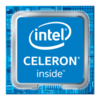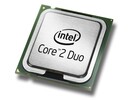Intel Celeron N5100 vs Intel Core 2 Duo T8300 vs Intel Core 2 Duo P8400
Intel Celeron N5100
► remove from comparison
The Intel Celeron N5100 is a quad-core SoC of the Jasper Lake series that is primarily intended for inexpensive notebooks and was announced in early 2021. The four Tremont CPU cores clock between 1.1 and 2.8 GHz (single core Burst) and offer no HyperThreading (SMT). The N5100 uses 1.5 MB L2 and 4 MB L3 cache. The chip is manufactured in 10nm at Intel (most likely in the same process as Ice Lake).
Architecture
The processor architecture is called Tremont and a complete redesign compared to the old Golmont Plus cores in the predecessor. According to Intel, the single thread performance of a core could be improved by 30% on average (10 - 80% in all tests of SPECint and SPECfp).
Features
In addition to the quad-core CPU block, the SoC integrates a 24 EU Intel UHD Graphics GPU clocked from 350 - 800 MHz and a LPDDR4(x) dual channel memory controller (up to 16 GB and 2933 MHz). The chip now also partly integrates Wi-Fi 6 (Gig+), 8 PCIe 3.0 lanes, 14 USB 2.0/ 3.2 ports and two SATA 6.0 ports. The package got bigger and measures 35 x 24 mm (compared to 25 x 24 mm for the N5030 e.g.). The SoC is directly soldered to the mainboard (BGA) and can't be easily replaced.
Performance
While we have not tested a single system powered by the N5100 as of August 2023, it's safe to expect the chip to be 10% to 20% slower than the N6000, as far as multi-thread performance is concerned. In other words, this is a fairly slow processor that is unlikely to make anybody happy.
Power Consumption
Like most other N-class Intel processors, this Celeron has a 6 W default TDP (also known as the long-term power limit). This is rather low; a small metal plate is all it takes to dissipate heat generated by such a CPU.
The Celeron N5100 is manufactured on Intel's first-generation or second-generation [no exact data available] 10 nm process for average, as of early 2023, energy efficiency.
Intel Core 2 Duo T8300
► remove from comparisonThe Intel Core 2 Duo T8300 was at the time of announcement a fast dual-core CPU for laptops with 3 MB level 2 cache. It is based on the Penryn core with all features enabled (but without the full 6MB level 2 cache). The later announced Core 2 Duo P7450 was cheaper and used less power.
Intel Core 2 Duo P8400
► remove from comparison
The Intel Core 2 Duo P8400 is a dual core processor for laptops. It features 2.26 GHz and a shared level 2 cache of 3 MB. Due to the smaller cache (Core 2 Duo T-Models got usually 6 MB at this clock rate), the TDP is only 25 Watt (instead of the 35 Watt of the T-models).
The performance of the P8400 is on par with the fast Turion II Ultra with about 2.4 to 2.6 GHz. Modern demanding games like Supreme Commander may be limited by the CPU performance. High end gamers should choose a higher clocked Core 2 Duo (or Core i5 / i7).
The P8400 uses a Penryn (Montevina Update) core that features 2 integer units, 1 floating point unit, 1 load unit, and 1 store unit in a 14-stages long pipeline. Due to the Wide Dynamic Execution Technology, the core is able to simultaneously execute up to four instructions.
The integrated Enhanced Speedstep is able to downclock the core dynamically as low as 800 MHz to save power (in idle mode).
The Core 2 Duo P8400 can be used in a Socket P socket with 479 pins: Socket P / Micro Flip-Chip Pin Grid Array (Micro-FCPGA) requires 479-pin surface mount Zero Insertion Force (ZIF) socket (mPGA479M socket) or Micro Flip-Chip Ball Grid Array (Micro-FCBGA) for surface mount (479-ball)
| Model | Intel Celeron N5100 | Intel Core 2 Duo T8300 | Intel Core 2 Duo P8400 | ||||||||||||||||||||||||||||||||
| Codename | Jasper Lake | Penryn | Penryn | ||||||||||||||||||||||||||||||||
| Series | Intel Jasper Lake | Intel Core 2 Duo | Intel Core 2 Duo | ||||||||||||||||||||||||||||||||
| Series: Core 2 Duo Penryn |
| ||||||||||||||||||||||||||||||||||
| Clock | 1100 - 2800 MHz | 2400 MHz | 2260 MHz | ||||||||||||||||||||||||||||||||
| L2 Cache | 1.5 MB | 3 MB | 3 MB | ||||||||||||||||||||||||||||||||
| L3 Cache | 4 MB | ||||||||||||||||||||||||||||||||||
| Cores / Threads | 4 / 4 | 2 / 2 | 2 / 2 | ||||||||||||||||||||||||||||||||
| TDP | 6 Watt | 35 Watt | 25 Watt | ||||||||||||||||||||||||||||||||
| Technology | 10 nm | 45 nm | 45 nm | ||||||||||||||||||||||||||||||||
| max. Temp. | 105 °C | 105 °C | 105 °C | ||||||||||||||||||||||||||||||||
| Socket | BGA1338 | BGA479, PGA478 | Socket P | ||||||||||||||||||||||||||||||||
| Features | DDR4-2933/LPDDR4x-2933 RAM, PCIe 3, GNA, MMX, SSE, SSE2, SSE3, SSSE3, SSE4.1, SSE4.2, VMX, SMEP, SMAP, EIST, TM1, TM2, Turbo, AES-NI, RDRAND, RDSEED, SHA | Virtualization (VT-x), Intel 64, Idle States, Enhanced Speedstep, Execute Disable Bit | SSE4.1, Virtualization Technology, Execute Disable Bit, Enhanced Speedstep, Ehnaced Halt State (C1E), 64 Bit, Trusted Execution Technology | ||||||||||||||||||||||||||||||||
| iGPU | Intel UHD Graphics (Jasper Lake 24 EU) (350 - 800 MHz) | ||||||||||||||||||||||||||||||||||
| Architecture | x86 | x86 | x86 | ||||||||||||||||||||||||||||||||
| Announced | |||||||||||||||||||||||||||||||||||
| Manufacturer | ark.intel.com | ark.intel.com | ark.intel.com | ||||||||||||||||||||||||||||||||
| FSB | 800 | 1066 | |||||||||||||||||||||||||||||||||
| Transistors | 410 Million | 410 Million | |||||||||||||||||||||||||||||||||
| Voltage | 1-1.25V V | 1.05-1.15 V | |||||||||||||||||||||||||||||||||
| Die Size | 107 mm2 | 107 mm2 | |||||||||||||||||||||||||||||||||
| $241 U.S. | $209 U.S. | ||||||||||||||||||||||||||||||||||
| L1 Cache | 128 KB |
Benchmarks
Average Benchmarks Intel Celeron N5100 → 0% n=0
Average Benchmarks Intel Core 2 Duo T8300 → 0% n=0
Average Benchmarks Intel Core 2 Duo P8400 → 0% n=0
* Smaller numbers mean a higher performance
1 This benchmark is not used for the average calculation













